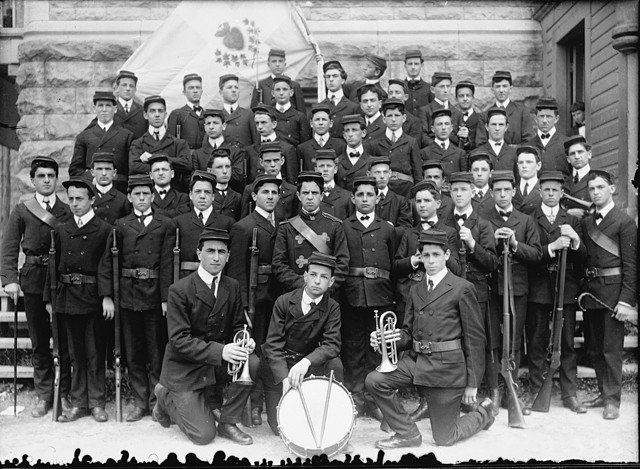Sandy Hill and the Great War

November 11, 2018 marks the hundredth anniversary of the Armistice that ended the War to end all wars. Although far from the battlefields, many Sandy Hill residents were profoundly affected by this war. Memorials in several Sandy Hill churches and the University of Ottawa list the names of the men who served and died. At the former All Saints Anglican church, the names of 19 parishioners who sacrificed their lives are recorded on a memorial plaque. Similar plaques can be found at St Joseph’s (353 parishioners enlisted, 31 died), St Alban’s (85 enlisted and 8 deaths) and St. Paul’s-Eastern (a combined 187 enlisted and 22 fatalities for the St. Paul’s Presbyterian and Eastern Methodist churches).
Not all were Sandy Hill residents, of course, but many of them were: they listed their addresses on Besserer, Henderson, Waller, Rideau, Nicholas, Cumberland, King Edward, Somerset, and more. The dead included the sons of prominent local residents, such as John McGee, the recently-retired clerk of the Privy Council (185 Daly Ave.) who lost two sons at the front and had a third wounded, and James Woods, a leading businessman and philanthropist (323 Chapel St.) who lost a son at the Battle of the Somme. But most of those who died came from ordinary families. Thanks to their medical examination at enlistment, we have some idea of what they looked like. We also know where their next of kin lived (usually parents or wife), whether they had children, their previous employment, if any, when they were shipped to England and then France, their regiment and service record, their pay, where and when they died and where they are buried (or remembered for those whose body was never found).
But in most cases, we do not know who they really had been, whether they had led happy lives, whether they had left a girlfriend behind or what they had aspired to become had the War not intervened. We can only guess at what they lived through while at the front and how the news of their death affected their loved ones back home.
Those who did not serve were also affected by the War. Fuel shortages forced the St. Paul’s Presbyterian and the Eastern Methodist churches to hold joint services during the cold season (the two churches would later merge). The career of architect Francis Sullivan, who lived at 346 Somerset E., took a turn for the worse when commissions dried up because of the War. Broke, he had to give up his house. In 1917, he designed a few military hospitals but left Ottawa the following year, never to return. James Woods’ business, however, thrived as he supplied tents and other military supplies to the Canadian army, including its first gas masks.
The War also gave rise to extraordinary philanthropic efforts. Lillian Freiman (née Bilsky), who grew up in Sandy Hill before moving to Somerset St. W., led sewing circles for the Red Cross in her living room, raised funds for displaced refugees and helped found the Great War Veterans’ Association of Canada (that later became the Canadian Legion). After the war, she raised funds for veterans’ organizations, headed Canada’s first Poppy Day campaign and went on to become affectionately known as the “Poppy Lady.” Almanda Marchand, one of whose sons was captured in combat, founded the Fédération des femmes canadiennes françaises to aid the war effort and organized volunteers to prepare care packages to be sent to the front. Mme Marchand stored these in the attic of her house at 240 Charlotte St.
Sir Robert Borden was Canada’s prime minister through the War, living on Wurtemburg Street just north of Rideau Street. In the summer of 1917, he agonized over the deep divisions between French and English created by the conscription crisis, and sought to create a union government with the Opposition Liberals led by Sir Wilfrid Laurier, who of course lived at 335 Laurier Ave. E. When Laurier refused (he opposed conscription), Borden considered resigning and asking the Governor General to name another Sandy Hill resident and member of the Supreme Court as interim prime minister, the Hon. Lyman Duff, (Duff lived at 30 Goulburn Ave. at the time). Conservative colleagues talked Borden out of resigning and he won the general election in the fall. Sandy Hill may have been far from the front but decisions on who would lead our country through one of its darkest hours involved three of our well-known residents.
On November 11, let us remember the contribution of all Sandy Hillers who served their country a hundred years ago.
Terry Byrne’s short biographical capsules of each of St Joseph’s parishioners who died at war can be seen in the church’s vestibule. More information is available online at the Library and Archives Canada website. You can read more Sandy Hill stories at history.ash-acs.ca.